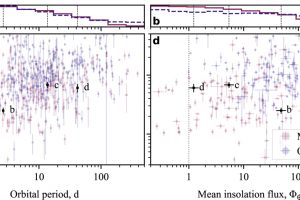A system of super-Earth exoplanets orbiting around GJ 3998 described in the paper: “HADES RV Programme with HARPS-N at TNG XVI. A super-Earth in the habitable zone of the GJ 3998 multi-planet system” of A. K. Stefanov (IAC)

At just 60 light-years away from us, the M-type star GJ 3998 hosts a system of three super-Earths, discovered and studied thanks to observations from the Telescopio Nazionale Galileo.
M-type stars are among the most important targets in the search for exoplanets, primarily for two reasons: they are the most numerous stars in our Galaxy, and the most commonly used techniques for detecting exoplanets—transits and radial velocity—are more effective for them compared to higher-mass stars. As a result of several decades of exoplanetary research, we now know that, for M-type stars in the Milky Way, hosting planets is more the rule than the exception.
The radial velocity technique involves measuring the small wobbles of stars caused by the gravitational interaction with their planets. These observations exploit the Doppler effect, which influences stellar radiation due to these oscillations. Since the velocities involved are typically on the order of meters or centimeters per second, instruments with extremely high spectral resolution are required to detect them. One of the most advanced instruments for this technique is HARPS-N, mounted on the Telescopio Nazionale Galileo. This instrument plays a key role in several projects dedicated to the study and characterization of exoplanets, including HADES (HARPS-N Red Dwarf Exoplanet Survey Radial Velocity), which began in 2012 and is led by astronomers from our observatory.
As part of the HADES project, a team of researchers led by astrophysicist A. K. Stefanov (Instituto de Astrofísica de Canarias, Departamento de Astrofísica) analyzed data from an extensive observation campaign of the M-type star GJ 3998, conducted with HARPS-N. This star, located just 60 light-years away, was already known to host two super-Earth-type planets, discovered in a 2016 study led by astronomers from our observatory.
The new observations not only confirm the presence of the two planets, with orbital periods of 2.6 and 13.7 days and masses of 2.5 and 6.8 Earth masses, but have also led to the discovery of a third planet of the same class, with a mass of 6.1 Earth masses and an orbital period of 41.8 days.
A unique feature of this new planet is the intensity of the radiation flux it receives from its star, which is very similar to what Earth receives from the Sun. This characteristic is shared by only a few known exoplanets to date.
The research is described in the article: “HADES RV Programme with HARPS-N at TNG. XVI. A super-Earth in the habitable zone of the GJ 3998 multi-planet system“, recently published in Astronomy & Astrophysics. Among the co-authors are astrophysicists L. Affer and G. Micela and astrophysicist J. Maldonado from INAF – Osservatorio Astronomico di Palermo.
The figure (click here to view it in full) shows two graphs comparing mass, period, density, and the intensity of incident radiation flux for planets known in the literature, alongside planets b, c, and d of GJ 3998. In particular, the right panel highlights how GJ 3998 d is one of the few known planets whose incident flux (mean insolation flux) is comparable to that of Earth.
Mario Giuseppe Guarcello
Follow MarioSpiegaCose on Instagram () , Facebook (), Youtube (), and X ()
Follow the Astronomical Observatory of Palermo on Facebok and on Instagram
Subscribe the Youtube channel of the Astronomical Observatory of Palermo
